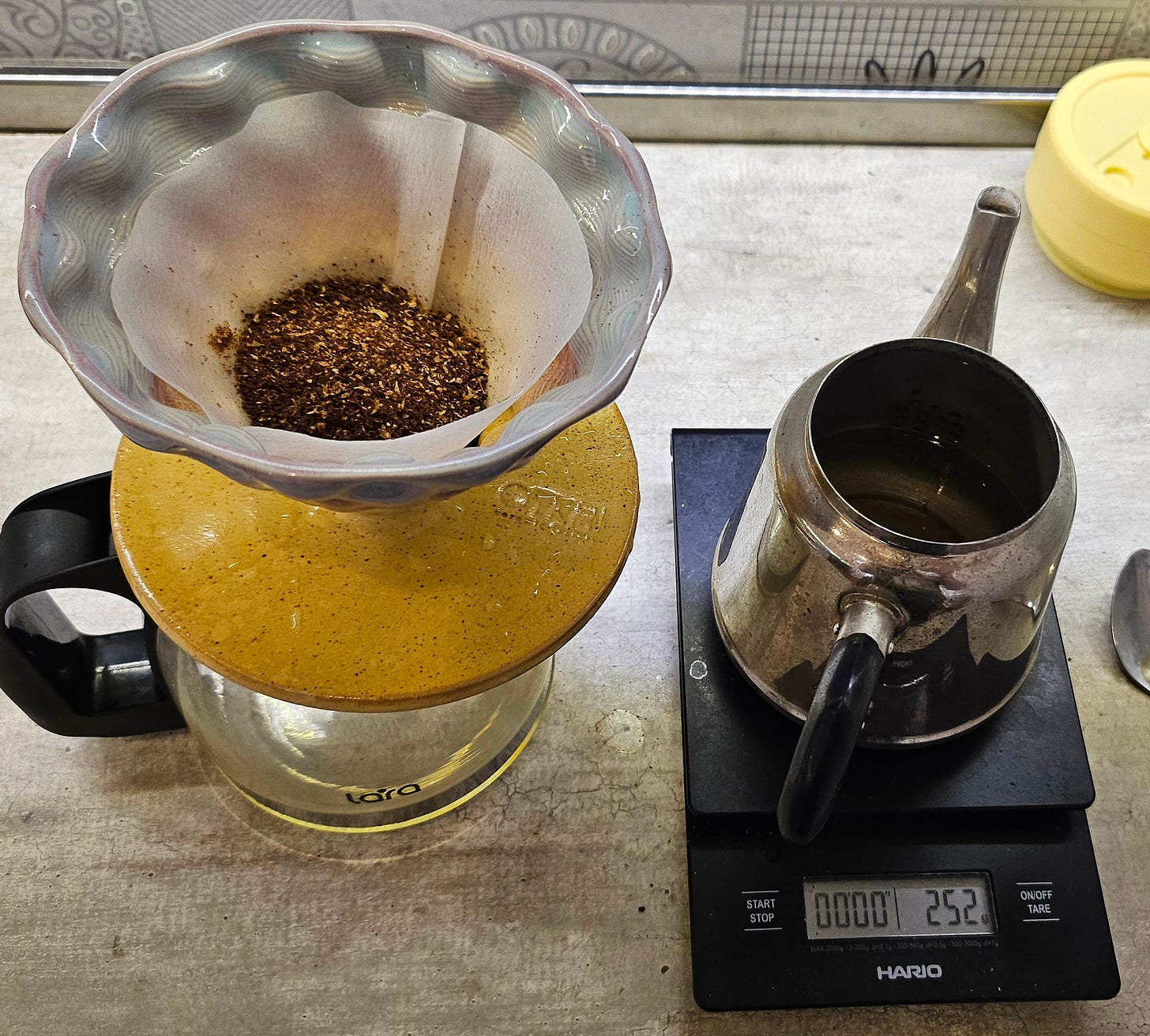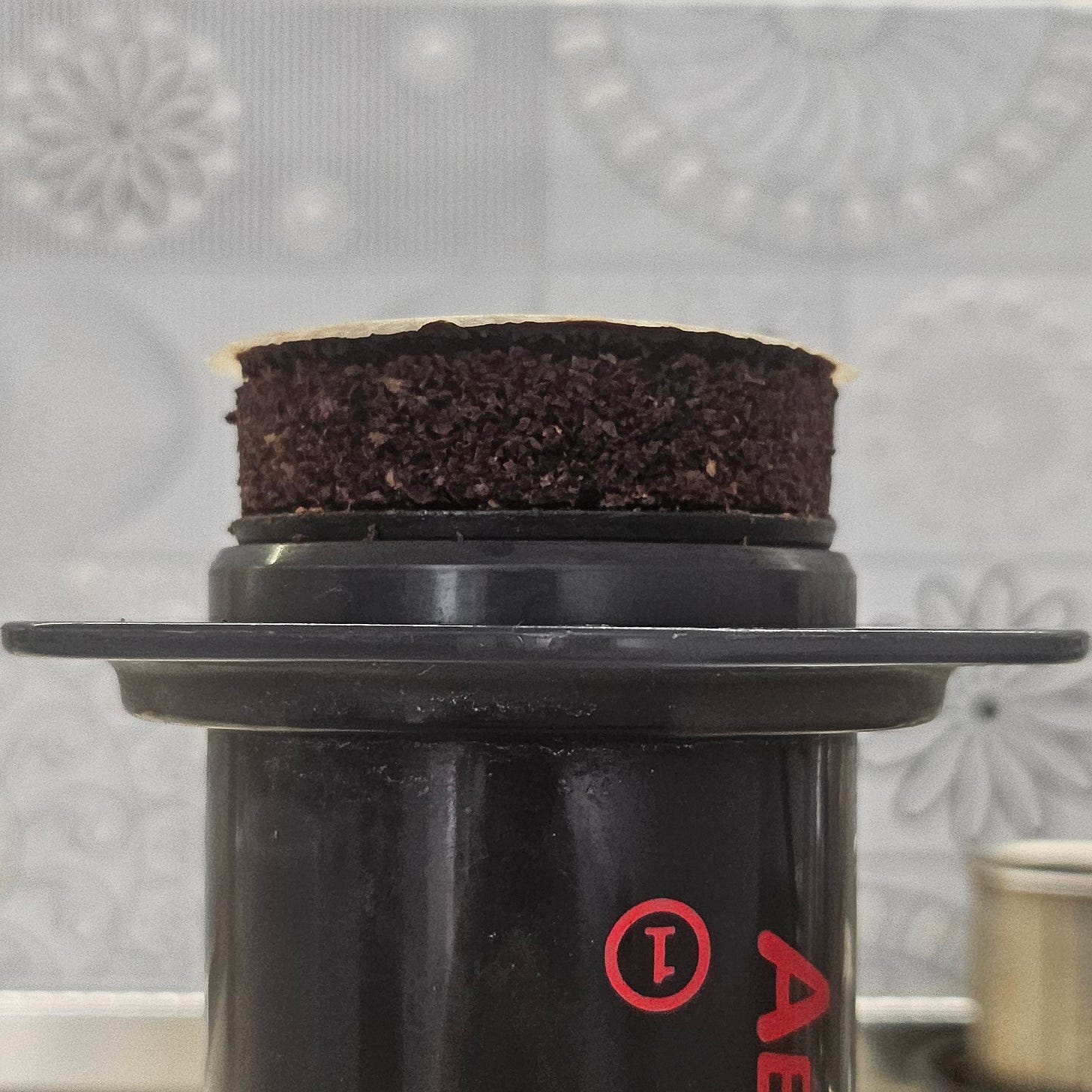I spent last week experimenting with newly acquired Probarista’s Microlot 2.0 (October 2024) beans. I found them interesting during the cupping that we went to the other day. They were a bit hard to make work well, so I thought this would be a good opportunity to talk through how I tune brewing variables for previously unseen beans.
I will mostly be talking about Aeropress experiments (for the reasons explained later), but I am including couple tries using the V60 too.
For both V60 and Aeropress, I will describe the general method that I use and the variables that we can tune there.
I will be making justifications for why I tweak certain variables certain way, so one may get a better understanding of how the influence the resulting cup
I’m yet again by no means expert, but know just enough to be dangerous.
Without further ado…
#1 1-Cup V60
V60 Method
I use a variant of Hoffmann’s Better V60 method. Even though he suggests it for a 1-cup brewing, I use pretty much the same method for both 1 and 2-cup brews. The steps are as follows:
Heat the water. Pre-wet the filter. Grind the beans. Put the grounds into the filter.
Pour 20% of water in about 10 seconds
Bloom until 35s to 45s (I go by the sound of the coffee dripping here; if it stops before 45, I shorten the bloom)
Pour another 20% of water in about 10 seconds
Wait for 10 seconds
Repeat 3 more times, until the water finishes
Wait for the drawdown. Stir. Serve.
NB: Sometimes 20% does not fit in the filter any more, if the water is dripping a bit more slowly, I just fill it to the brim and adjust the waiting times on the fly. I don’t aim for the perfect timing there, it’s just a good guideline to have.
Bean to water ratios that I tend to use is 15g to 250g for 1-cup, and 30g to 500g for 2-cup. Grind size I would call medium-coarse, usually between 25 and 30 clicks on my Comandante X25 (it’d be the same on C40 right?).
V60 Variables
There’s a bunch of variables we can vary to tune our recipe:
Timings. The longer the contact of beans with water, the more water can extract. I haven’t experimented much with this, but from my personal experience and what I read online, I just try to aim for the drawdown to finish by 2:00-3:00.
Agitation. It affects the extraction too, but harder to describe. Again I didn’t do much experiments with V60 and agitation, and just go by the rules outlined in the Hoffmann’s video. I really recommend watching it to anyone brewing V60 at home.
Grind size. First of all, it affects how long it takes for the water to drawdown (the finer, the longer); we do not want our brewing take too long. The other point is how it affects the taste: too coarse and our coffee might be too acidic and lacking in everything else, too fine and our coffee is too bitter without much acidity.
Ratio (bean to water). The more coffee we put, the more there’s for water to extract. However, we can go too far and not have enough water and/or time to extract everything there is (grind size also plays into this)
As you can see, there are quite a few things that affect the brew. But let’s just brew something, and see what we get
Beans: 15g. Water: 250g. 26 clicks.
Timings:
35s to bloom
1m 35s finished pouring
4m 15s drawdown (this is way too long, not a good sign)
The resulting coffee is fruity and sweet. The leafiness and savouriness that I saw during the cupping is present, but very faintly. It’s quite smokey and bitter, not too unpleasant though.
Overall, not bad for a first try (I suspected these beans will be weird and tricky to tune into). But it’s a single cup only, and the drawdown was long. Plus, I want more of that chickpeas flavour.
#2 2-Cup V60
Next try, I went with the same recipe but for two cups. I adjusted the grind size to be a little coarser, thinking it might reduce the bitterness, and give more flavour. The only caveat I only had small (number 1) V60 cones, which are often two small for 500g of water, so I didn’t have much hope.
Beans: 30g. Water: 500g. 28 clicks.
Timings:
45s to bloom
5m 44s finished pouring
Over 6 minutes to drawdown
The filter clogged a lot. Significantly more bitter, the opposite of what I wanted. No ‘green’ flavour at all. Practically terrible. But yeah, I didn’t have much hopes, you know. Let’s switch over from V60 to an Aeropress instead, I have a feeling that it may work better there.
#3 Basic 1-cup Aeropress
Aeropress Method
I, again, use an adapted Hoffmann’s Aeropress technique.
Heat the water. Grind the beans. Assemble an Aeropress. Put the grounds in.
Pour water, wetting all the grounds. Put the plunger in, and pull a little bit to create the vacuum inside (this ensures that the water does not drip out of the chamber as much)
Let it sit for 2 minutes
Swirl the Aeropress gently to agitated the grounds, and break the crust
Let it sit for 30 more seconds
Push the plunger all the way
Stir. Serve.
For grind size, I usually grind to fine or medium-fine size — 15 to 20 clicks on X25. The usual ratio is 12-13g of beans to 270g of water. I never tried the inverted method, but I never experienced any problems with just brewing upright that people describe
Aeropress Variables
They are pretty much the same as the V60, but with a bit of a twist:
Timings. How long do we let it brew for. Both the initial time, and time after swirling (I’ll record it as X+Y). The longer the time, the more we extract. There’s a potential for “over-extraction” and our brew will be overly bitter. But it is much more controllable than with V60, obviously. I tend to just use 2m+30s, but adjusting the timings has proven to be useful couple times before.
Grind size. Same thing here. Too coarse and we have it too acidic. Too fine and we have it too bitter.
Ratio. Pretty much the same deal as with V60. More beans — more stuff to extract. However, too much and we cannot extract everything. Going finer with higher ratio is an option though (which I use for 2-cup method).
Temperature. I didn’t mention it before, as I pretty much always brew with boiling hot (100C) water. However, sometimes it’s useful to go lower. I do not understand the physics of the process, but with 80-90C you can make the brew more acidic, seemingly keeping the same level of bitterness. I’m mentioning it now, ‘cause I’ve actually tried adjusting for Aeropress this time.
Pressure. With Aeropress we can adjust how much pressure we apply when pouring the drink. Generally, if the pressure is too low, the resulting brew might be too flat. Too high and we might push the fines through the filter making the brew muddy.
So, the standard 1-cup Aeropress brew. I have gone with coarser grounds than usual, since we saw that the V60 brew was overly bitter.
Beans: 13.2g. Water: 270g. 24 clicks. Timing: 2m + 30s. Temp: 100C
Certainly, more smell than before, surprisingly! However, the taste is a little flat, and less interesting overall.
At that point, I was not sure whether it’s too coarse or too fine (not too acidic, not too bitter, just flat), but I was sure enough that the grind size is wrong. Also, potentially there’s not enough beans — I’ve seen with OKRO’s Indonesia before, where I had to use more beans for Aeropress to get good flavour out. So, this try is a failure, we can do better.
#4 Higher ratio and coarse 1-cup Aeropress
Let’s try adjusting a few things at a time — the previous try was way off — coarser grounds, higher ratio, longer time.
Beans: 13g. Water: 250g. 30 clicks. 2m 30s + 30s
Well, this one not pleasant either. Still pretty flat — likely should have gone finer instead. Not bitter per se, but there’s this general “over-extraction” unpleasantness (I think the general consensus is that you cannot over-extract with immersion brewing, but I don’t know how else to describe it frankly) — it’s been brewing for too long. There’s more of a flavour though, so I think increasing the ratio was a good call.
Well, go finer instead, and default timings.
#5 Finer grounds 1-cup Aeropress
Beans: 13g. Water: 250g. 20 clicks. 2m + 30s.
This one actually starts resembling a good cup of coffee. Decently rich flavour, pleasantly bitter and the hint of grassy savouriness is back. However, this cup was not sour enough.
Usually, I’d grind coarser to bring more sourness, but we’ve seen in #3 and #4 it doesn’t work for these beans. Instead, we can lower the temperature — not something I do very often!
#6 Lower temperature 1-cup Aeropress
Beans: 13.8g. Water: 230g. 20 clicks. 2m + 30s. 90C.
This brew was already pretty good. Punch fruity acidity similar to #1. Enough of chickpeas “soupy-ness”, mostly in the aftertaste though. However, this time it’s too sour, and not bitter enough (I liked the smoky-bitter taste of some of the previous cups).
#7 A/B test: coarser or finer 1-cup Aeropress
In order to try to bring back the pleasant bitterness, let’s try a slightly finer grind settings, keeping everything else the same.
A) Beans: 13.8g. Water: 230g. 20 clicks. 2m + 30s. 90C
B) Beans: 12g. Water: 200g. 18 clicks. 2m + 30s. 90C
The ratio is the same in both cups, it’s just that the B was brewed for my wife who usually drinks smaller cups.
Both are still fruity-sour, but B is a tiny bit more savoury. However, the bitterness is still not quite back. I think keeping this grind settings we can try hot water again.
#8 Hot water again 1-cup Aeropress
Beans: 13.8g. Water: 230g. 18 clicks. 2m + 30s. 100C
Initially thought that it was flat, but forgot to let it cool down. Not too sour, balanced bitterness. Soft, savoury and leafy (I’m still amazed by this property, first time I’m drinking something like this). At this point I am quite satisfied with the taste. Great cup — final recipe for 1-cup Aeropress using Probarista’s Microlot 2.0 (October 2024) Ethiopia.
Discussion
One can see that it took me quite a few tries to get the recipe right — total beans used is 137.6g, over half a bag! Usually it takes only couple tries to get a good cup though. It’s just this time the beans behaved differently enough, that I needed to understand how to make the work. Funnily enough, this time the trick was to just go a tiny bit finer and use more coffee beans, huh. I’m not sure why these beans require quite a higher ratio, usually I am satisfied with a lower ratio for an Aeropress.
I have continued using recipe #8 for this bag and consistently got perfectly flavourful savoury and smokey-bitter cup of coffee. I would have liked to continue brewing them, alas I bought the last bag of that microlot, so it’s gone for now.
In the interest of time, I have omitted couple tries of a 2-cup bypass Aeropress method recipes I did, since they were quite boring anyway. However, I should probably talk about 1-cup vs 2-cup recipes some other time too.











